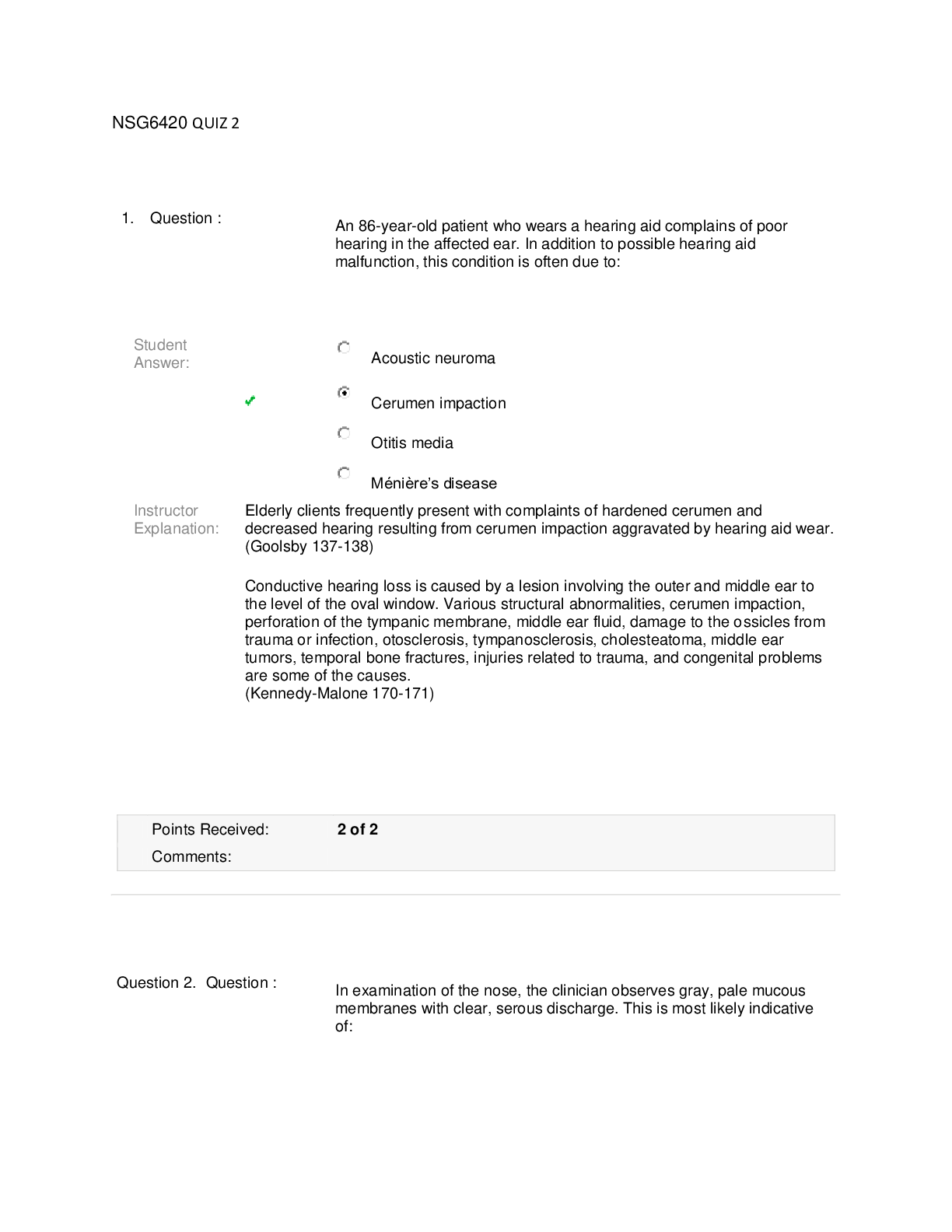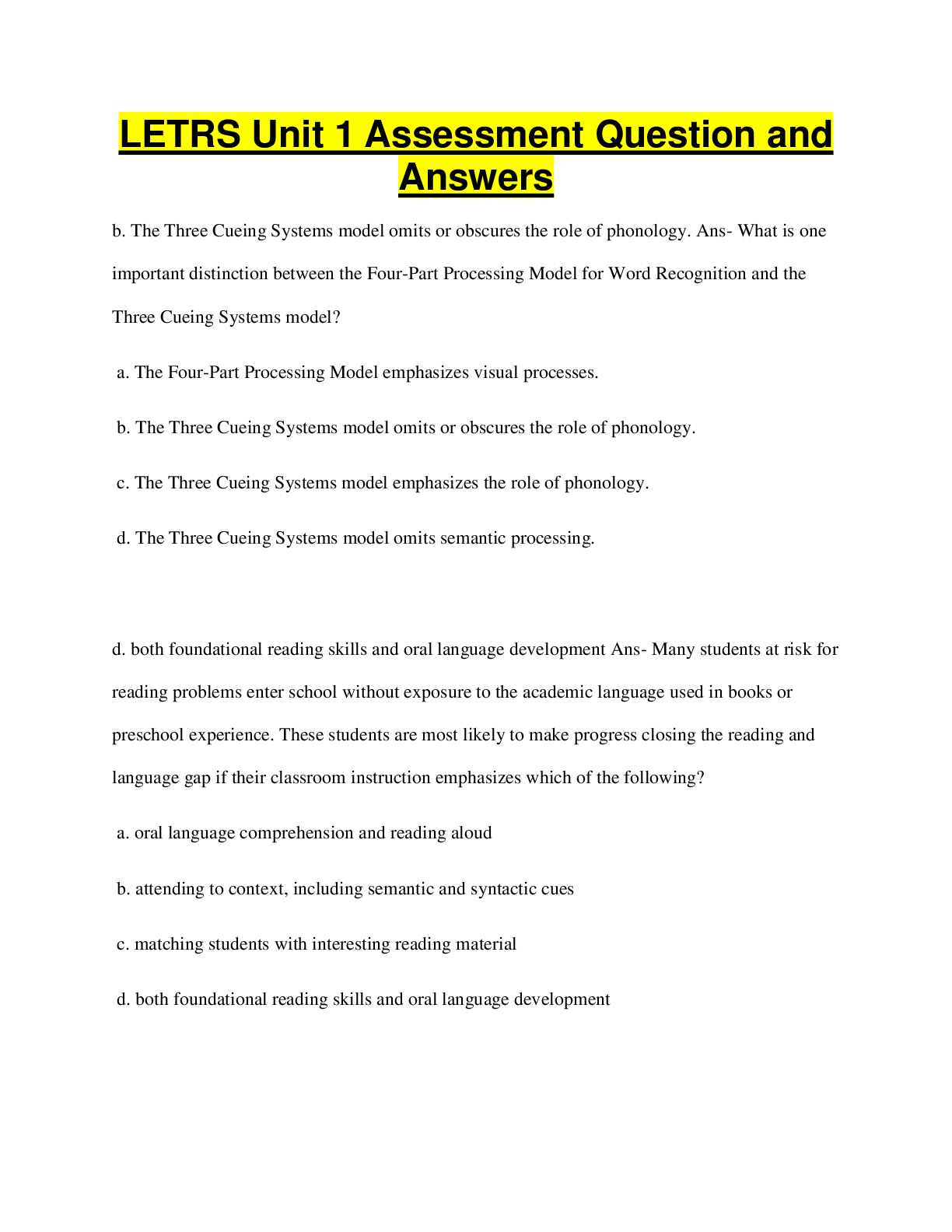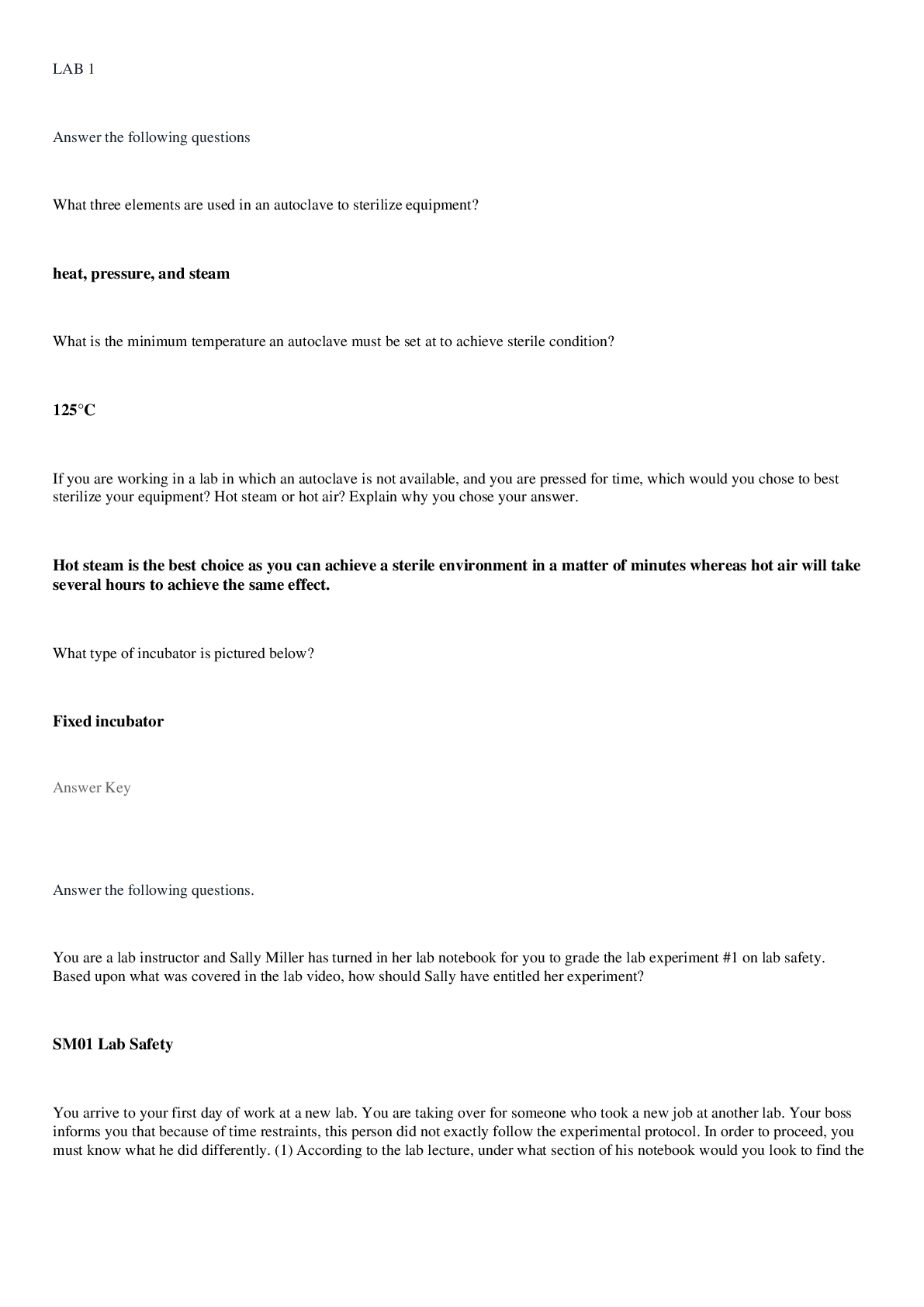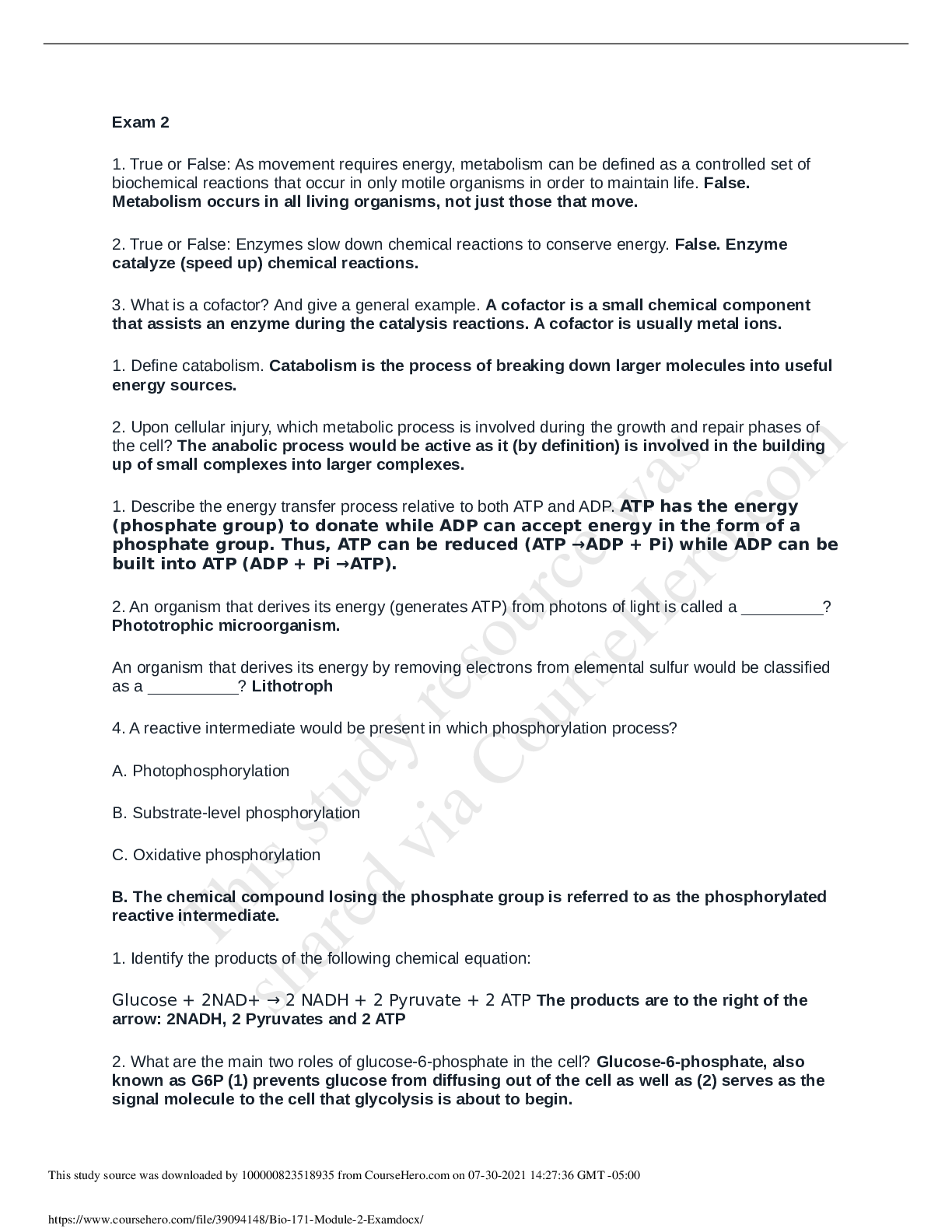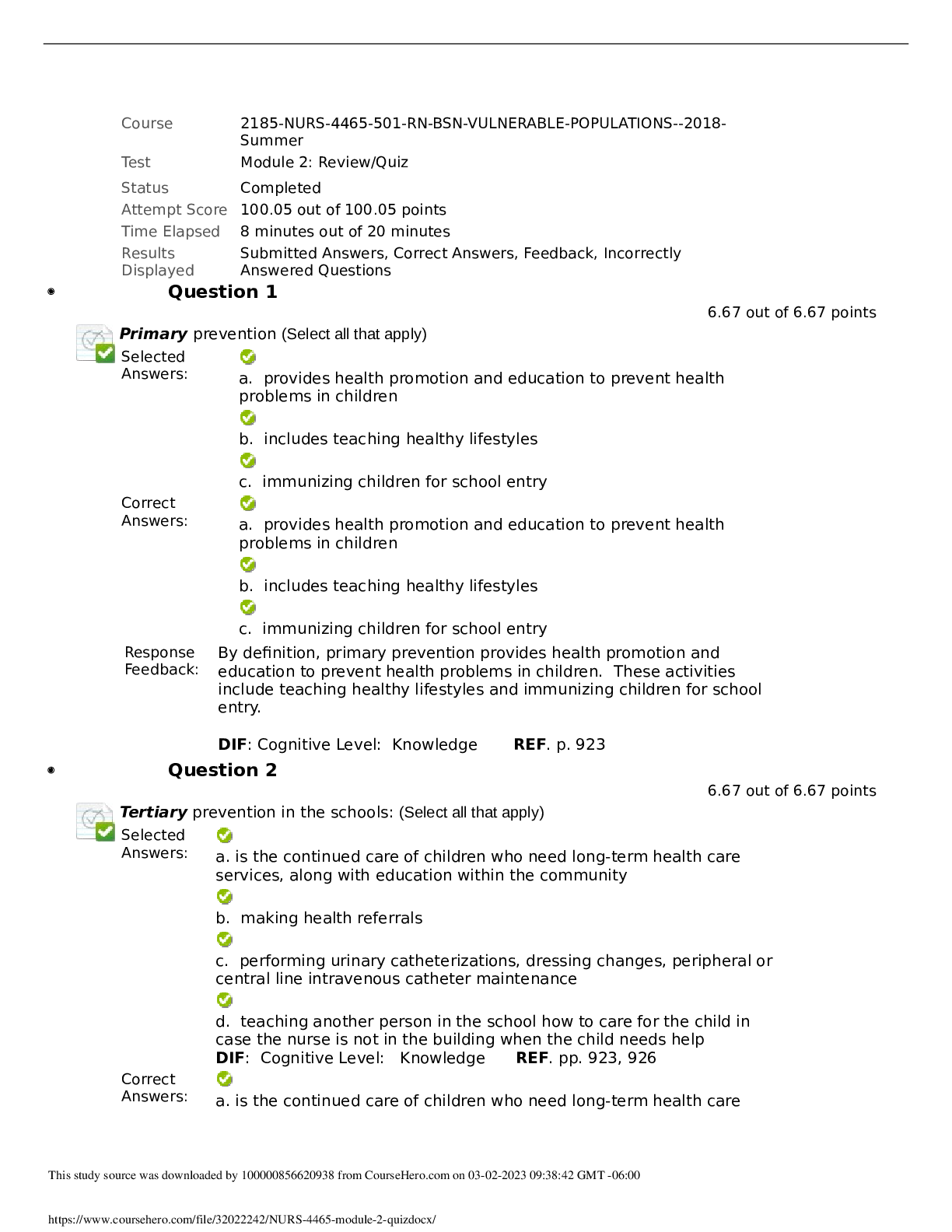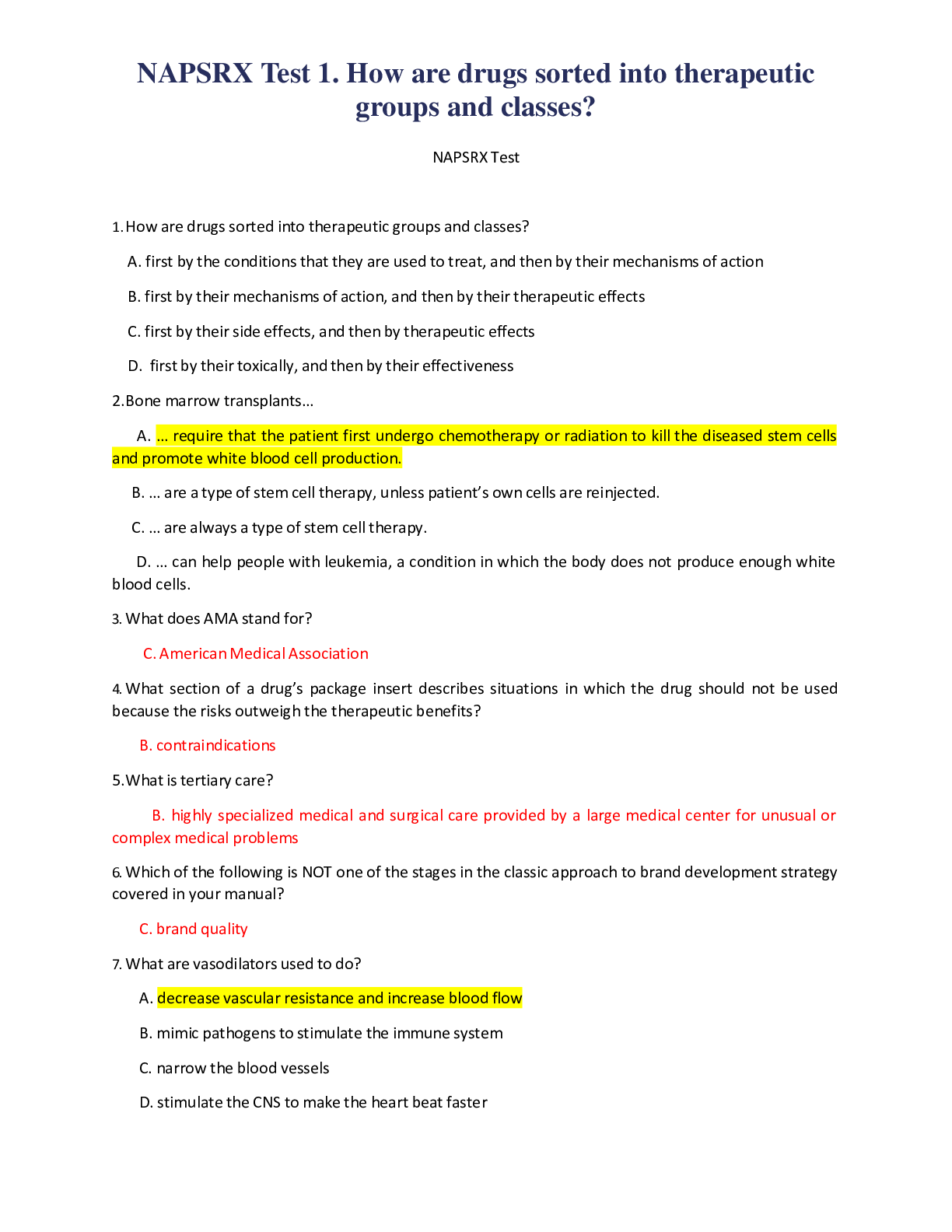*NURSING > EXAM > NSG 6420 QUIZ 2 Questions and Answer Solutions | 100% VERIFIED | ANSWERED and Guaranteed pass | Sout (All)
NSG 6420 QUIZ 2 Questions and Answer Solutions | 100% VERIFIED | ANSWERED and Guaranteed pass | South University, Savannah
Document Content and Description Below
NSG 6420 QUIZ 2 1 Question : An 86-year-old patient who wears a hearing aid complains of poor . hearing in the affected ear. In addition to possible hearing aid malfunction, this condition is... often due to: Student Answer: Acoustic neuroma Cerumen impaction Otitis media Ménière’s disease Instructor Explanation: Elderly clients frequently present with complaints of hardened cerumen and decreased hearing resulting from cerumen impaction aggravated by hearing aid wear. (Goolsby 137-138) Conductive hearing loss is caused by a lesion involving the outer and middle ear to the level of the oval window. Various structural abnormalities, cerumen impaction, perforation of the tympanic membrane, middle ear fluid, damage to the ossicles from trauma or infection, otosclerosis, tympanosclerosis, cholesteatoma, middle ear tumors, temporal bone fractures, injuries related to trauma, and congenital problems are some of the causes. (Kennedy-Malone 170-171) Question 2. Question : In examination of the nose, the clinician observes gray, pale mucous membranes with clear, serous discharge. This is most likely indicative of: Student Answer: Bacterial sinusitis Allergic rhinitis Drug abuse Skull fracture Instructor Explanation: When examining the nose, assess the mucosa for integrity, color, moistness, and edema/lesions and the nasal septum for patency. The turbinates should be assessed for color and size. Pale, boggy turbinates suggest allergies; erythematous, swollen turbinates are often seen with infection. Any discharge should be noted. Clear, profuse discharge is often associated with allergies. (Goolsby 128-129) Patients with seasonal allergic rhinitis report rhinorrhea, sneezing, obstructed nasal passages, and pruritic eyes, nose, and oropharynx during the spring and fall. Patients with perennial allergic rhinitis have similar symptoms associated with exposure to environmental allergens typically in their homes. Physical examination may reveal a pale, boggy nasal mucosa, injected conjunctiva, enlarged turbinates, dark discoloration or bags under the eyes, and mouth breathing; absence of pale, boggy nasal mucosa does not rule out allergic rhinitis. (Kennedy-Malone 182-183) Question 3. Question : A 45 year old patient presents with ‘sore throat’ and fever for one week. After a quick strep screen you determine the patient has Strep throat. You know that streptococcal pharyngitis should be treated with antibiotics to prevent complications and to shorten the course of disease. Which of the following antibiotics should be considered when a patient is allergic to Penicillin? Student Answer: Instructor Explanation: Amoxicillin EES (erythromycin) Bicillin L-A Dicloxacillin MedU Card #1 Question 4. Question : Presbycusis is the hearing impairment that is associated with: Student Answer: Physiologic aging Ménière’s disease Cerumen impaction Herpes zoster Instructor Explanation: Presbycusis is an age-related cause of gradual sensorineural hearing loss and involves diminished hairy cell function within the cochlea as well as decreased elasticity of the TM. Although the changes associated with presbycusis often start in early adulthood, the decreased hearing acuity is usually not noticed until the individual is older than 65. (Goolsby 138) Because presbycusis is gradual and insidious, hearing loss may go unnoticed until it has progressed significantly. (Kennedy-Malone 170) Question 5. Question : Epistaxis can be a symptom of: Student Answer: Over-anticoagulation Hematologic malignancy Cocaine abuse All of the above Instructor Explanation: Cocaine abuse, which is more common than might be expected, frequently causes epistaxis. Hematologic disorders likely to cause bleeding include thrombocytopenia, leukemia, aplastic anemia, and hereditary coagulopathies. High doses of anticoagulants can cause epistaxis and bleeding from the gums. (Goolsby 142) Epistaxis results from a spontaneous rupture of a blood vessel in the nose, usually in the anterior septum in Kiesselbach's plexus (Nguyen, 2012). The bleeding may be secondary to local infections, systemic infections, drying of the nasal mucous membrane, trauma, arteriosclerosis, hypertension, or bleeding disorders. Trauma is usually the primary mechanism of disruption of the nasal mucosa. Posterior epistaxis can result in nausea and respiratory compromise. In older adults, nasal and paranasal tumors may be involved (Mäkitie, 2010). (Kennedy-Malone 168-169) Question 6. Question : Your patient has been using chewing tobacco for 10 years. On physical examination, you observe a white ulceration surrounded by erythematous base on the side of his tongue. The clinician should recognize that very often this is: Student Answer: Malignant melanoma Squamous cell carcinoma Instructor Explanation: Aphthous ulceration Behcet’s syndrome Most oral malignancies are painless until quite advanced, so patients are often unaware of the lesion unless the lip or anterior portion of the tongue is involved. The patient may become aware of the lesion if it bleeds. Squamous cell cancer lesions vary in appearance, from the reddened patches of erythroplakia to areas of induration/thickening, ulceration, or necrotic lesions. Lesions of malignant melanoma have varied pigmentation, including brown, blue, and black. Even lesions that appear flat and smooth may be nodular, indurated, or fixed to adjacent tissue on palpation. Even though patients with squamous cell malignancies often have a history of heavy alcohol and/or tobacco use or poor dentition, these are not risk factors for malignant melanoma. In Behcet’s syndrome, the patient complains of recurrent episodes of oral lesions that are consistent with aphthous ulcers. The number of lesions ranges from one to several; the size of the ulcers varies from less than to greater than 1 cm. Like aphthous ulcers, the lesions are well defined, with a pale yellow or gray base surrounded by erythema. The majority of patients also develop lesions on the genitals and eyes. (Goolsby 153) Tobacco use and heavy alcohol consumption, alone or synergistically, are strongly related to the development of oral cancer. Pipe smoking and sun exposure have been implicated in lip cancer. Leukoplakia and erythroplasia are often precursors to oral cancer. Relationships between oral cancer and Epstein-Barr virus, HPV, herpes simplex virus, and immunodeficiency states also have been found (Stenson, 2011). (Kennedy-Malone 177). Question 7. Question : A 26 year old patient presents with cough and general malaise for 3 days. They note that their eyes have been watering clear fluid and a ‘runny nose’ since yesterday. They note they ‘feel miserable’ and demand something to make them feel better. What would be the best first plan of treatment? Student Answer: Instructor Explanation: Saline nasal spray for congestion and acetaminophen as needed for pain. Z-pack (azithromycin) for infection and Cromolyn nasal for congestion Hydrococone/acetaminophen as needed for pain and Guaifensin for congestion Cephalexin for infection and Cromolyn ophthalmic for congestion MedU Card #4 Question 8. Question : Which of the following findings should trigger an urgent referral to a cardiologist or neurologist? Student Answer: vision History of bright flash of light followed by significantly blurred History of transient and painless monocular loss of vision History of monocular severe eye pain, blurred vision, and Instructor Explanation: ciliary flush All of the above Amaurosis fugax is a monocular, transient loss of vision. It stems from transient ischemia of the retina and presents an important warning sign for impending stroke. Depending on the circumstances reported, the patient should be immediately referred to either a cardiovascular or neurological specialist. (Goolsby 108) Question 9. Question : Dizziness that is described as "lightheaded" or, "like I'm going to faint," is usually caused by inadequate cerebral perfusion and is classified as? Student Answer: Instructor Explanation: Presyncope Disequilibrium Vertigo Syncope MedU Card #5 Question 1 0. Question : It is important to not dilate the eye if is suspected. Student Answer: Cataract Macular degeneration Acute closed-angle glaucoma Chronic open-angle glaucoma Instructor Explanation: If the patient has experienced sudden onset of eye pain, it is important not to dilate the eyes before determining whether acute closed-angle glaucoma is present because dilating the eye may increase the intraocular pressure. (Goolsby 108) Acute glaucoma, also known as angle-closure or narrow-angle glaucoma, is an obstruction to the outflow of aqueous humor from the posterior to the anterior chamber through the trabecular meshwork, canal of Schlemm, and associated structures. It results in an elevation of intraocular pressure, damaging the optic nerve and causing loss of peripheral vision, eye pain, and redness. This type of glaucoma is uncommon but may occur as a primary disease or secondary to other conditions and constitutes an ophthalmic emergency (Kennedy-Malone 161) Question 1 1. Question : Mr. GC presents to the clinic with nausea and vomiting for 2 days, prior to that time he reports occasional ‘dizziness’ that got better with change in position. He denies a recent history of URI or any history of headaches or migraines. What would the most likely diagnosis be? Student Answer: Instructor Explanation: Vestibular neruitis Benign paroxysmal positional vertigo Vestibular migraine Benign hypertensive central vertigo MedU Card #9 Question 1 2. Question : Which of the following patients with vertigo would require neurologic imaging? Student Answer: A 68-year-old woman with a history of hypertension and sudden acute onset constant vertigo. She has right nystagmus that changes direction with gaze and that does not disappear when she focuses. A 45-year-old man with recurrent episodes of brief intense vertigo every time he turns his head rapidly. He has no other neurologic signs or symptoms. He has a positive Dix-Hallpike maneuver. A 66-year-old man with recurrent episodes of vertigo associated with tinnitus and hearing loss. His head thrust test is positive. Instructor Explanation: A 28-year-old otherwise well woman with new onset constant vertigo with no other neurologic symptoms. On physical exam, she has unidirectional nystagmus that disappears when her gaze is fixed. MedU Card #11. There are multiple reasons to be concerned about a central lesion and possible infarct in this patient. Her age puts her at risk as does her hypertension. Her physical exam shows nystagmus that changes direction and that does not inhibit with focus. Both of these findings are consistent with a central lesion. She needs an urgent MRI. Question 1 3. Question : A patient presents with eye redness, scant discharge, and a gritty sensation. Your examination reveals the palpable preauricular nodes, which are most likely with: Student Answer: Bacterial conjunctivitis Allergic conjunctivitis Chemical conjunctivitis Viral conjunctivitis Instructor Explanation: Preauricular nodes are nonpalpable and nontender in allergic conjunctivitis, usually nonpalpable in bacterial conjunctivitis, and palpable in viral conjunctivitis. (Goolsby 112) Question 1 4. Question : In assessing the eyes, which of the following is considered a “red flag” finding when associated with eye redness? Student Answer: Instructor Explanation: History of prior red-eye episodes Grossly visible corneal defect Exophthalmos Photophobia Red flag warnings for eye redness include pain (not discomfort or irritation), decreased vision, profuse discharge, and corneal defect grossly visible. (Goolsby 112) Question 1 5. Question : A 64-year-old male presents with erythema of the sclera, tearing, and bilateral pruritus of the eyes. The symptoms occur intermittently throughout the year and he has associated clear nasal discharge. Which of the following is most likely because of the inflammation? Student Answer: Bacterium Allergen Virus Fungi Instructor Explanation: Patients with seasonal allergic rhinitis report rhinorrhea, sneezing, obstructed nasal passages, and pruritic eyes, nose, and oropharynx during the spring and fall. Patients with perennial allergic rhinitis have similar symptoms associated with exposure to environmental allergens typically in their homes. Physical examination may reveal a pale, boggy nasal mucosa, injected conjunctiva, enlarged turbinates, dark discoloration or bags under the eyes, and mouth breathing; absence of pale, boggy nasal mucosa does not rule out allergic rhinitis. (Kennedy-Malone 182-183) Question 1 6. Question : Patients that have atopic disorders are mediated by the production of Immunoglobulin E (IgE) will have histamine stimulated as an immediate phase response. This release of histamine results in which of the following? Student Answer: Instructor Explanation: Sinus pain, increased vascular permeability, and bronchodilation Bronchospasm, vascular permeability, and vasodilatation Contraction of smooth muscle, decreased vascular permeability, and vasoconstriction Vasodilatation, bronchodilation, and increased vascular permeability Rhinitis may be either allergic or nonallergic. Allergic rhinitis results as a response of the nasal mucosa to airborne allergens in atopic genetically prone individuals. This response is mediated by the production of immunoglobulin E (IgE). IgE antibodies produced in response to the initial and subsequent exposure to allergens bind to the nasal mucosa. With repeated exposure, immediate type 1 hypersensitivity reactions may occur (Simoens & Laekeman, 2009). Antigen-specific T cells are activated through the lymphatic system in response to the antigen. The activated antigen-specific T cells activate B cells, and IgE is created in lymphoid tissue and at local tissue sites (Adelman, Casale, & Corren, 2002; Novak, 2009). The newly created antigen-specific IgE is released by plasma cells and binds to high-affinity IgE receptors located on the basophils and mast cells. This leads to the sensitization of the cells in the tissues of the nose, lung, or skin (Adelman et al., 2002; Cirillo, Pistorio, Tosca, & Ciprandi, 2009). IgE also binds with the antigen protein, beginning degranulation of the mast cells and basophils. These actions start the allergic cascade. Mediators are released as a result of the degranulation and include histamine, proteoglycans, enzymes, leukotrienes, cytokines, and many others. The chain in the release of mediators is responsible for the immediate and late phase responses of the cells. Histamine may be fully released within 30 minutes of degranulation, whereas cytokines may be released over many hours (Adelman et al., 2002; Derendorf & Meltzer, 2008). (Kennedy-Malone 181-182) Question 1 7. Question : You have a patient complaining of vertigo and want to know what could be the cause. Knowing there are many causes for vertigo, you question the length of time the sensation lasts. She tells you several hours to days and is accompanied by tinnitus and hearing loss. You suspect which of the following conditions? Student Answer: Instructor Explanation: Ménière’s disease Benign paroxysmal positional vertigo Transient ischemic attack (TIA) Migraine Ménière's disease commonly involves a triad of symptoms—severe vertigo, tinnitus, and hearing loss (Goolsby 140) Question 1 8. Question : In examining the mouth of an older adult with a history of smoking, the nurse practitioner finds a suspicious oral lesion. The patient has been referred for a biopsy to be sent for pathology. Which is the most common oral precancerous lesion? Student Answer: Fictional keratosis Keratoacanthoma Lichen planus Leukoplakia Instructor Explanation: The cause of most episodes of leukoplakia is not determined. However, this condition, which results in the development of white patches on the oral mucosa, is associated with an increased risk of oral squamous cell cancer. Risk factors for the development of leukoplakia include chronic/recurrent trauma to the affected site and the use of smokeless and smoked tobacco and alcohol. (Goolsby 152) Question 1 9. Question : Rheumatic heart disease is a complication that can arise from which type of infection? Student Answer: Epstein-Barr virus Diphtheria Group A beta hemolytic streptococcus Streptococcus pneumoniae Instructor Explanation: Group A beta-hemolytic streptococcal (GABHS) pharyngitis is a bacterial infection of the pharynx, commonly called strep throat. Complications of GABHS pharyngitis, although rare, include rheumatic heart disease and glomerulonephritis, and the condition requires prompt diagnosis and definitive treatment. Most patients with GABHS pharyngitis are children and youths. Other bacterial causes of pharyngitis include mycoplasmal pneumonia, gonorrhea, and diphtheria. (Goolsby 156) Question 2 0. Question : A patient complains of fever, fatigue, and pharyngitis. On physical examination there is pronounced cervical lymphadenopathy. Which of the following diagnostic tests should be considered? Student Answer: Mono spot Strep test Throat culture All of the above Instructor Explanation: The physical examination for sore throat should include a comprehensive assessment of the upper and lower respiratory systems, including ears, nose, mouth, throat, and lungs. The neck assessment should include, at a minimum, assessment of the cervical lymph nodes. Strep screens, throat cultures, and mononucleosis screens are common diagnostic studies used to narrow the differential diagnosis of sore throat. A CBC with differential count is helpful in determining the cause of sore throat. (Goolsby 156) [Show More]
Last updated: 1 year ago
Preview 1 out of 11 pages
 (1).png)
Reviews( 0 )
Document information
Connected school, study & course
About the document
Uploaded On
Oct 18, 2021
Number of pages
11
Written in
Additional information
This document has been written for:
Uploaded
Oct 18, 2021
Downloads
0
Views
42



.png)










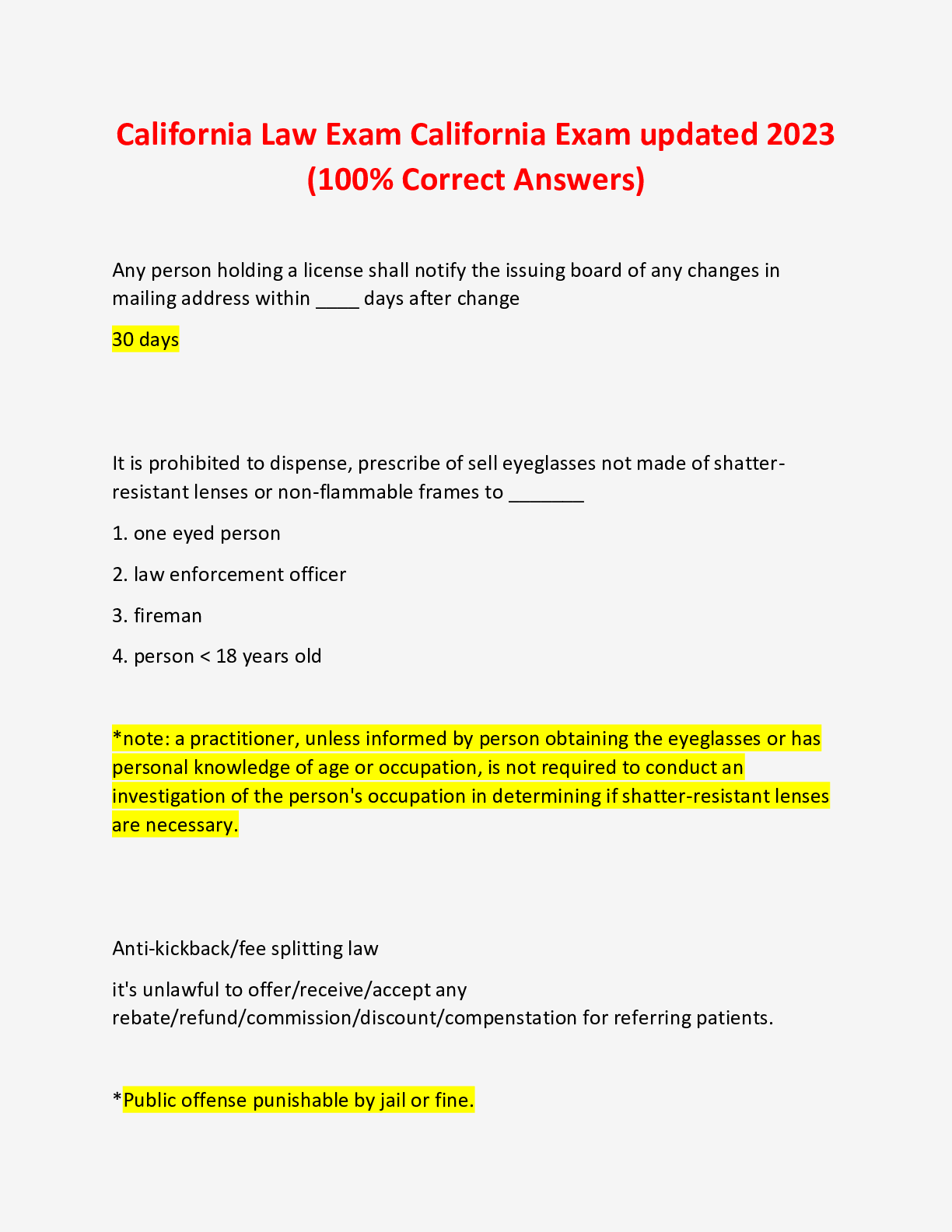



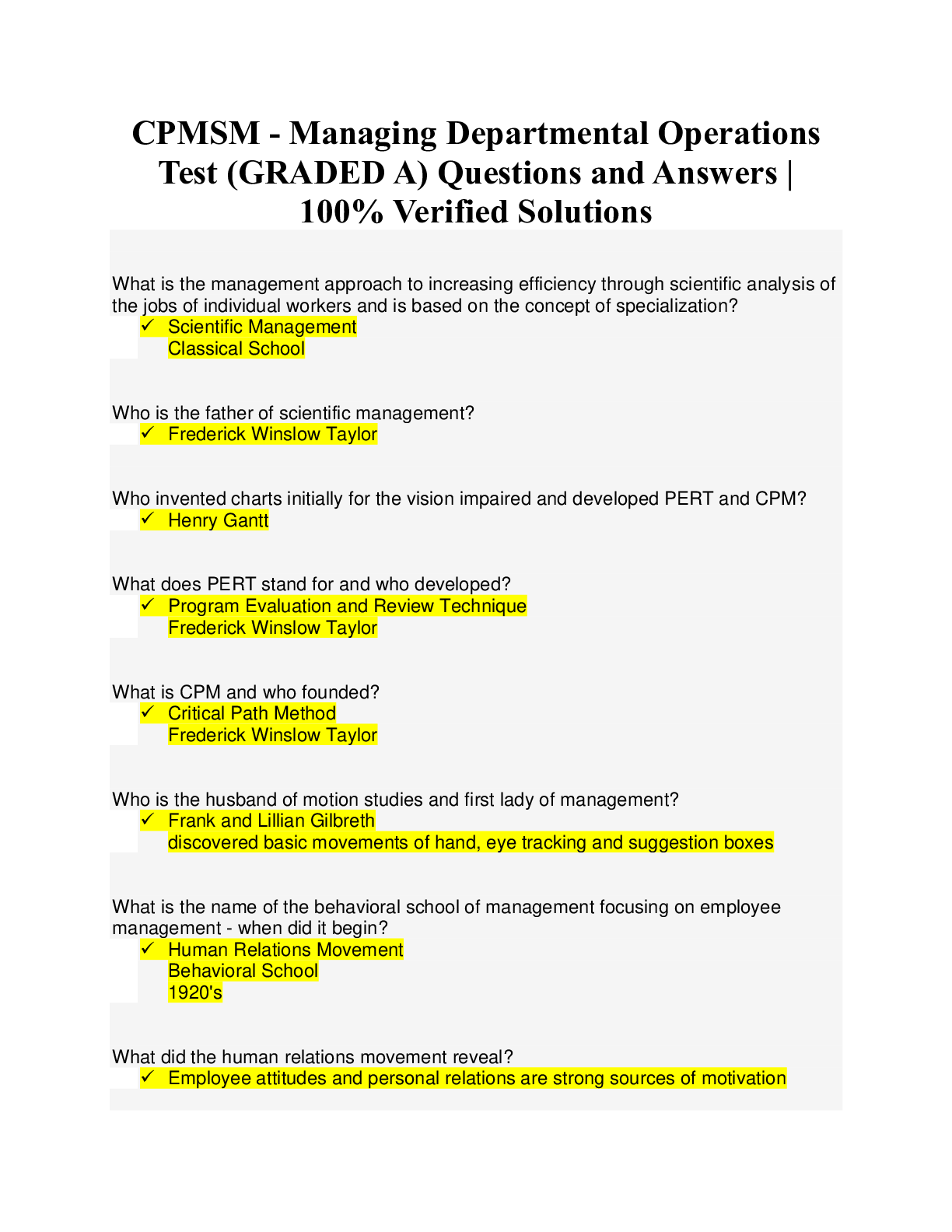
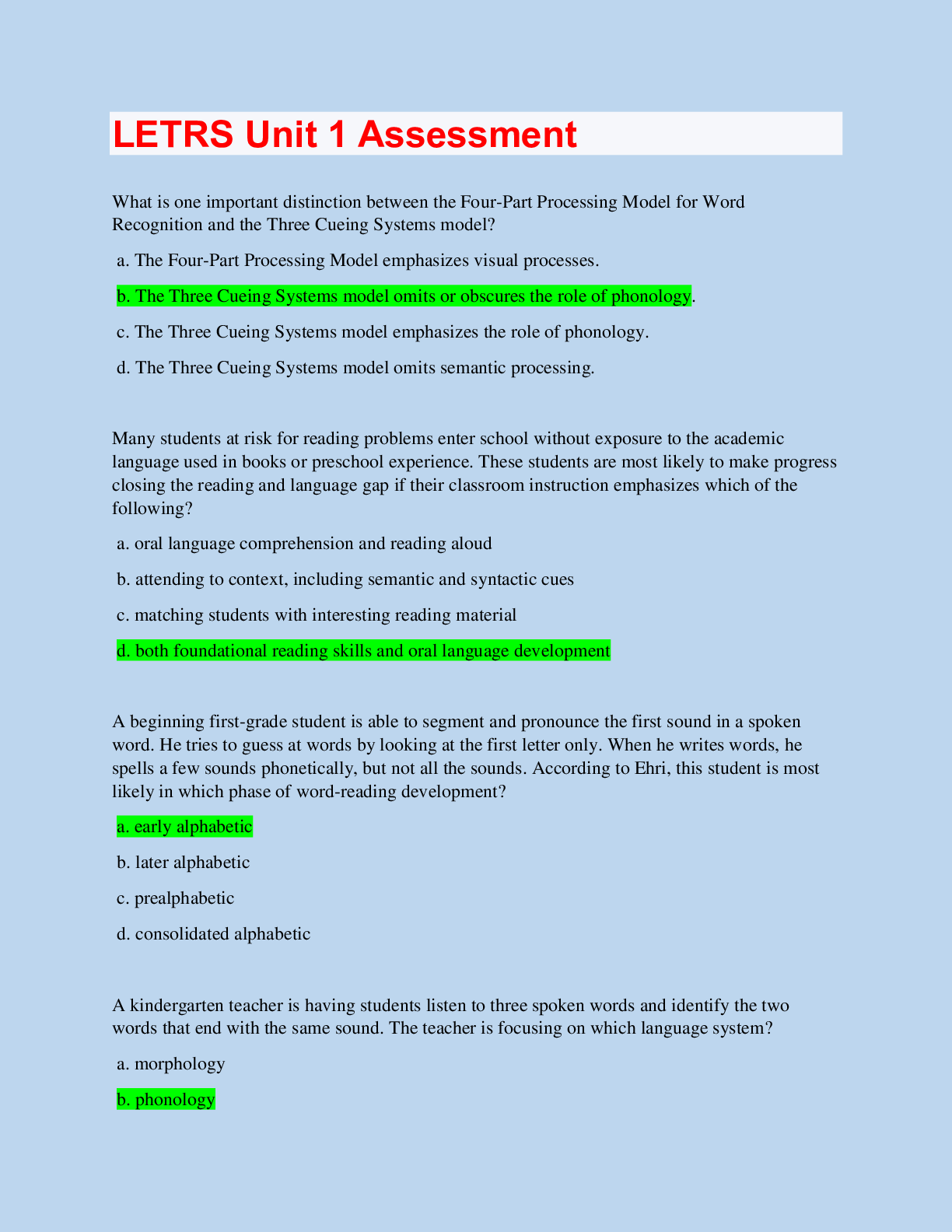
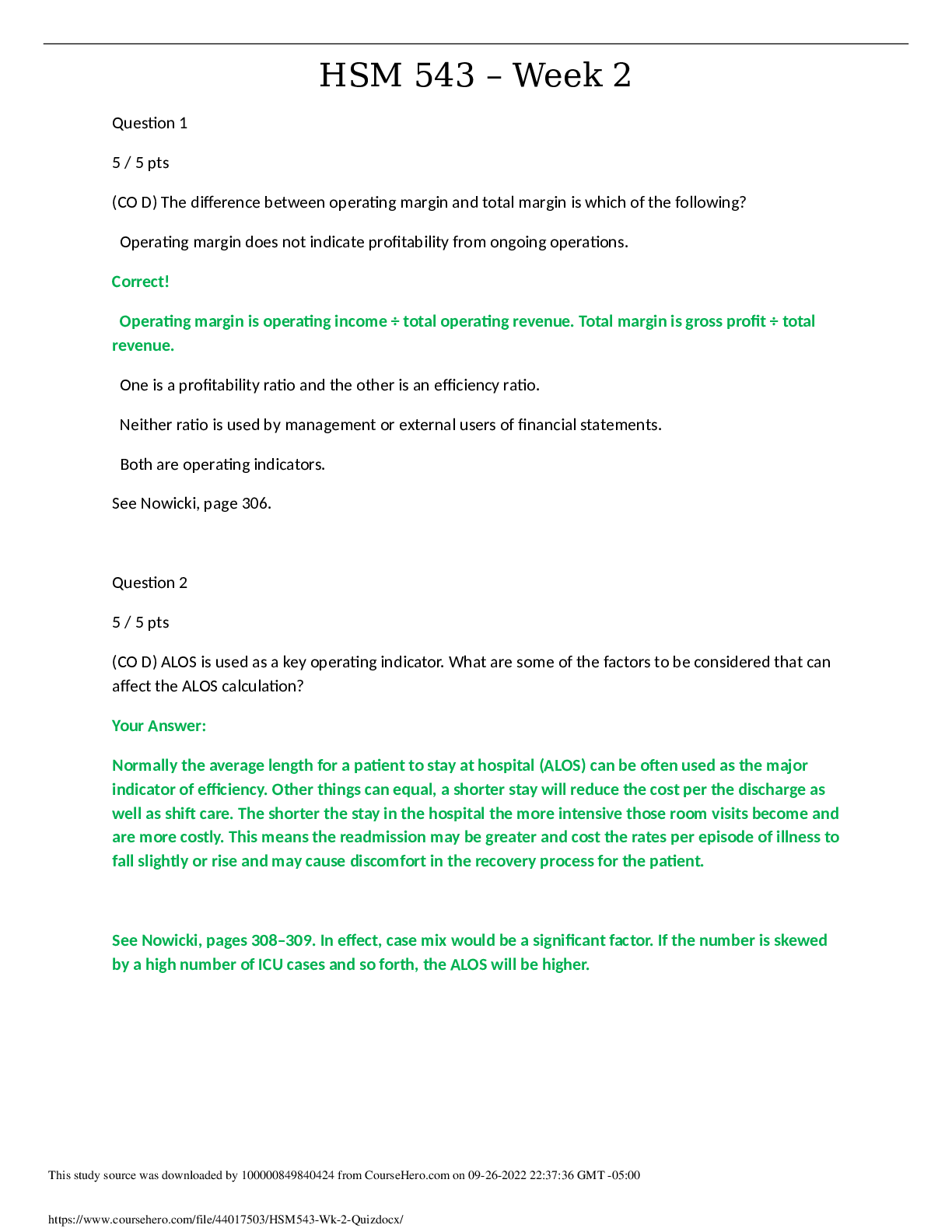
 (1).png)

